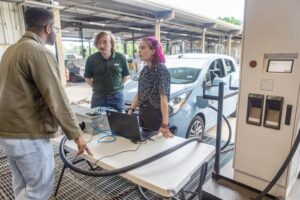Interview: Jo Lovell Director of Inclusive Communities at Cwmpas on tackling digital exclusion in Wales
We live increasingly online. Apps and sites make it ever easier to access public services — and more economical to supply them. But what about those who aren’t online?
It’s estimated that 180,000 people aged 16 and over in Wales, some 7% of the country, are digitally excluded. Jo Lovell at Cwmpas tells Infotec how that’s being addressed…
How do we measure digital exclusion?
The Lloyds Bank Consumer Digital Index is recognised across the UK but when our government cites statistics, these are taken from the National Survey for Wales. That sometimes means there’s a bit of disparity between figures. Either way, it’s clear that older people are more likely to be excluded, and the percentage increases when you get beyond 75. People with disabilities and long-term health conditions, as well as those in low income households also tend to be the most digitally excluded.
Digital exclusion isn’t linear, it can change — and quickly. Technology is evolving quicker than our digital skills, more and more people are cancelling their broadband and relying on mobile data and WiFi as a result of the cost of living crisis. The problem is multi-faceted. To be digitally included you need: the skills and confidence to get online and engage safely, a device, connectivity (fixed/mobile), and support.
What do you do for such people?
There are 25 of us in the team here, so we can’t reach all these individuals ourselves. We work with organisations including the public sector, housing associations, and health and social care providers. We ensure that their staff have the skills and confidence to engage digitally, so they can then support their end users to be more involved online. Through our programme partner the Good Things Foundation, we encourage organisations to become digital hubs, promote Learn My Way courses and to access the national data and device banks.
We also work with the organisations to think about the way they embed digital inclusion in their work and policies, putting users first. That can be from a strategic level, conducting digital skills audits with staff, to delivering training.
The main thing is find the ‘hook’ to motivate someone to engage with technology. Setting up an email address isn’t exactly inspiring, and asking someone to manage a bank account online is a big step forward. But if they’ve got a passion for music and you show them Spotify or YouTube, and how they can listen to artists they love, they’ll want to do that for themselves. As people become more confident and learn how to be safe online they will do more, like using apps for banking or managing their health conditions such as diabetes.
Some of the things we do are quite innovative. For example, we use smart speakers – something so simple which can help people to be more independent. We’ve been using VR headsets in care homes, providing a supportive, immersive experience for older people and people with dementia. There are apps for reminiscence work. We try to inspire people, using tech as an enabler to help people be more independent and improve their well-being.
Who pays for this work?
The Welsh government funds our Digital Communities Wales: Digital Confidence, Health and Wellbeing programme. It’s jointly funded through social justice and health. As more and more health services have moved online, it was realised that the people most likely to need to engage with them are the ones most digitally excluded. We saw this with Covid, where everything had to go online and there were people left behind, unable to engage, because they didn’t have those skills.
With any given individual who is digitally excluded, what is the process?
As I said, we don’t work with end users because we don’t have a big enough team. Wales is also quite rural and getting around to them can be a challenge. We do skills audits with organisations, using the essential digital skills framework. That includes the ability to get online, to be safe online, to set up an email and things of that sort. But we tailor our work to the organisation. They know their end users who aren’t online or don’t engage with digital services so we create programmes to train the trainers, who can then support those end users.
How many people do you support in this way?
Between April 2022 to March 2023 our work reached over 40,000 people across Wales. This was through direct support to organisations, face to face and online training delivered by one of our team, or self-serve online courses through programme partners. For each individual we train in an organisation, we know they will go on to support at least five people.
Can you give me an example of an organisation you’ve worked with in this way?
There are lots. We work with every local authority across Wales. We’ve also done a lot of work with the housing sector and work really closely with the registered social landlords. We work with charities, such as RNIB. Part of our programme focuses specifically on working in minority ethnic communities. We also manage loan devices, so that people can use them in, say, a care home setting and see the benefits for themselves. During the pandemic, we distributed about 1,100, iPads or similar devices to just over 600 care homes. Residents in care homes could use them to have their GP consultations virtually, and to engage with family and friends. A lot of the care homes didn’t have that kind of technology, or didn’t have the skills to use them, so we also did a lot of training — in the middle of the pandemic.
You said you work at a strategic level with organisations. What does that involve?
A lot of it is sharing knowledge and building partnerships. Digital Inclusion Alliance Wales (DIAW) is a network of more than 90 organisations from all sectors that have committed to signing the digital inclusion charter and are working to improve digital inclusion within their own organisations so they can then support people externally. I’m also a member of the Digital Poverty Alliance. I was at the Digital Inclusion Symposium in Edinburgh with representatives from Welsh government and from local authorities all over the UK. We all know this is an issue that needs to be addressed.
If you’re not working directly with end users, do you get a sense of the impact you have on people?
We do. We’ve been delivering this work for more than 15 years and the monitoring of it used to be very focused on key-performance indicators in that way. I also did a lot of work with the Welsh government on this. Our work is very much based on a theory of change — not that we’ve trained 1,000 people, which is great, but on looking at the actual impact made. We do a lot of survey work to get feedback on the training. We capture case studies on an organisational and individual level.
About 12 months ago, we gifted devices to First Choice Housing Association, who provide accommodation solutions for people with disabilities, veterans and additional complex needs. About a fifth of their tenant population didn’t have access to a device so we were able to gift them just over 200 of them. Then we’ve done some longitudinal studies with the tenants and captured individual case studies. During the pandemic, that meant they felt less isolated, they were able to engage online, attend different online classes such as in cookery, and be part of different groups.
Jo Lovell, thank you very much.
Interview: AR app ‘Dorothy’ helps people living with dementia

















Leave a Reply